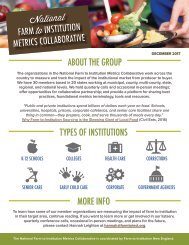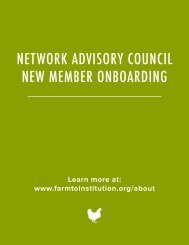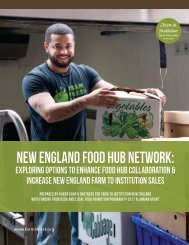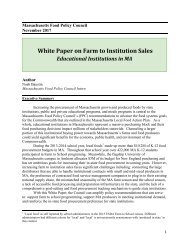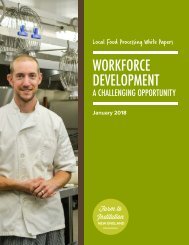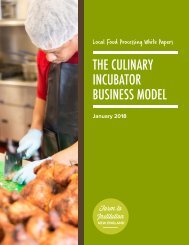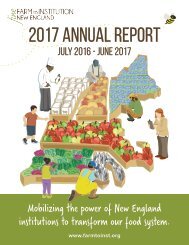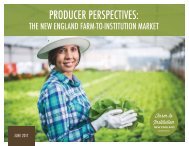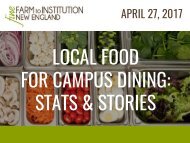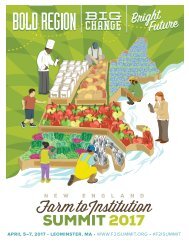Campus Tracking Infographic V3
You also want an ePaper? Increase the reach of your titles
YUMPU automatically turns print PDFs into web optimized ePapers that Google loves.
Keep on<br />
TRACKING LOCAL FOOD<br />
HOW BETTER DATA MANAGEMENT SYSTEMS CAN INCREASE<br />
LOCAL FOOD PROCUREMENT AT NEW ENGLAND CAMPUSES<br />
Farm to<br />
Institution<br />
NEW ENGLAND<br />
WHY TRACK?<br />
Increasingly, campus administrators, prospective students,<br />
and other stakeholders want to see the impact of local and<br />
sustainable food purchases at New England colleges and<br />
universities. Accurate, affordable, user-friendly tracking<br />
systems are needed for campuses to collect baseline<br />
purchasing data, set meaningful goals, and measure<br />
progress toward purchasing commitments. Despite a high<br />
level of involvement and interest among campuses in New<br />
England, the systems currently used are often costly and<br />
vary significantly across the region.<br />
DIG IN!<br />
A full report on<br />
interview findings<br />
with more detailed<br />
information about<br />
tracking successes<br />
and challenges will<br />
soon be available on<br />
FINE’s website!<br />
www.farmtoinst.org<br />
INTERVIEWS WITH TEN CAMPUSES The New England Farm &<br />
The New England Farm and Sea to <strong>Campus</strong> Network (FSCN), an initiative of Farm<br />
to Institution New England (FINE), conducted in-depth interviews with dining and<br />
sustainability managers from ten different campuses to evaluate the variety of ways<br />
that campuses in New England are currently tracking their local and sustainable food<br />
purchases. By offering some initial insights, FINE and FSCN hope to catalyze the<br />
development of best practices for local food procurement. This fact sheet highlights key<br />
findings, good ideas, and potential snags from the pilot interviews, which complements<br />
FINE’s 2015 <strong>Campus</strong> Dining Survey.
NEW ENGLAND CAMPUS DINING SURVEY<br />
In 2015, FINE surveyed colleges and universities in New England and received responses from<br />
half of the campuses (105 out of 209). After analyzing the results, we published the findings in<br />
a report titled “<strong>Campus</strong> Dining 101: Benchmark Study of Farm to College in New England.”<br />
98%<br />
of responding campuses plan<br />
on purchasing more local<br />
food over the next three years<br />
35%<br />
of responding campuses<br />
aren’t aware of or aren’t using<br />
any tracking system<br />
Key Findings<br />
The results showed that nearly all responding New England<br />
colleges and universities surveyed are interested in purchasing<br />
more local and sustainable food. Not surprisingly, many of<br />
them currently use a variety of methods to track their local food<br />
purchases. Almost a third (32%) used distributor reports and a<br />
fifth (21%) use customized tools to track local food purchases.<br />
However, about a third (35%) of the responding colleges used<br />
none of the tools to track their local purchases (N=100).<br />
[ ]<br />
To better understand how New England campuses are using tracking<br />
systems to evaluate their food purchasing, and explore the effectiveness of<br />
those systems, FINE conducted extensive interviews with ten New England<br />
campuses. The results are summarized in this publication.<br />
IT’S A BIG DATA PROBLEM...<br />
When campuses track their local and sustainable food purchases, they often use two or three different<br />
systems. Why? The campuses we interviewed have multiple sustainability commitments, and there<br />
simply isn’t a system that currently exists with the capacity to easily track everything at once.<br />
Examples of<br />
<strong>Tracking</strong> Systems<br />
AASHE STARS<br />
Real Food Calculator<br />
Farm to Fork - Bon Appetit<br />
Foodbuy - Compass Group<br />
Vermont First - Sodexo<br />
FoodPro<br />
Spreadsheets<br />
Customization vs. Automation<br />
When choosing a tracking system, there is a common tradeoff<br />
between customization and automation. Customized<br />
spreadsheets allow dining managers the flexibility to track local<br />
and sustainable food purchases using any criteria they want, but<br />
require a huge amount of work. On the other hand, integrated<br />
ordering systems with built-in tracking, like those used by many<br />
food service management companies (FSMCs), are more efficient.<br />
However, they don’t allow individual campuses to track goals that<br />
fall outside of the FSMC corporate sustainability commitments.<br />
Good Ideas<br />
• Gather purchasing data from every month of the year,<br />
not just two or three.<br />
• Develop a common tracking system that strikes the right<br />
balance of efficiency and flexibility to meet campus needs.<br />
[<br />
7 10<br />
]<br />
OUT OF<br />
campuses we interviewed use<br />
two or more tracking systems
Staffing supPORT IS CRITICAL<br />
Since campuses may have more than one procurement goal and thousands of products to track, it can<br />
take a significant amount of time and resources to figure out which products meet local and sustainable<br />
criteria. Our interviews suggest that the level of support offered by FSMCs, universities, and third parties<br />
varies widely across New England, from temporary student interns to dedicated regional technical<br />
assistance. Successful systems often rely on dedicated staff or student interns for whom tracking is a<br />
primary responsibility.<br />
Good Ideas<br />
• For campuses, use a sustainability manager to operate<br />
tracking systems and coordinate stakeholders across<br />
campus departments.<br />
• For FSMCs, designate one employee to streamline data<br />
requests from suppliers and distribute information to<br />
multiple campus accounts to improve efficiency.<br />
Potential Snags<br />
Without an engaged and educated campus<br />
community, it can be difficult to establish<br />
purchasing priorities and justify allocating<br />
resources for tracking systems.<br />
TRANSPARENCY AND ACCOUNTABILITY ARE KEY<br />
<strong>Tracking</strong> provides an opportunity to improve transparency in the food supply chain and maintain<br />
accountability to sustainability commitments. Our pilot study suggests that including stakeholders such<br />
as administrators, students, community members, and business leaders in decision-making is vital to<br />
establishing procurement goals and functional tracking systems to match them.<br />
Good Ideas<br />
• Create a formal advisory committee representing<br />
diverse stakeholders. The committee can help to<br />
inform purchasing commitments and hold everyone<br />
accountable year to year.<br />
• Set clear purchasing commitments that are written into<br />
university policies and food service contracts,<br />
LOCAL DEFINITIONS ARE SUBJECTIVE<br />
Good Idea<br />
Request velocity reports from suppliers in the most universal<br />
data format possible, such as spreadsheets with columns<br />
specifying the zip code of each food product origin. This<br />
allows any definition of local to be tracked at any time.<br />
Potential Snags<br />
• Without stakeholder involvement, local<br />
food goals can fall through the cracks.<br />
• Some tracking systems are proprietary,<br />
making it harder for campuses to shop<br />
around for the right one.<br />
According to FINE’s 2015 campus dining survey, the top three definitions of local food that New England<br />
colleges report using are procurement of foods within 250 miles (29%), within the state (27%), or within<br />
New England (26%). The interviews revealed that local food could come from an area as small as the<br />
state of Rhode Island or as large as the Northeast region of the United States. Additionally, some<br />
campuses look at other factors when determining if food is “local,” such as if the company has less than<br />
$5 million in revenue or is independently owned.<br />
Potential Snag<br />
Although tempting, the variety of local<br />
food definitions used today makes it<br />
difficult to accurately compare campus<br />
efforts to one another.
PARTICIPATING CAMPUSES<br />
The following campuses participated in our<br />
2017 interviews, which informed this fact sheet.<br />
CAMPUS STATE STUDENT ENROLLMENT TYPE OF OPERATION<br />
The Hotchkiss School CT 635 Sodexo<br />
Wesleyan University CT 3,262 Bon Appetit<br />
Western Connecticut State University CT 6,176 Sodexo<br />
Smith College MA 3,162 Self-operated<br />
UMASS Amherst MA 28,084 Self-operated<br />
Worcester State University MA 6,204 Chartwells<br />
Colby College ME 1,815 Bon Appetit<br />
Unity College ME 573 Self-operated<br />
University of Rhode Island RI 16,451 Self-operated<br />
University of Vermont VT 13,478 Sodexo<br />
COMMON TRACKING<br />
CHARACTERISTICS<br />
• Sustainable seafood<br />
• Organic<br />
• Fair trade<br />
• Certified humane<br />
• Cage-free eggs<br />
• Antibiotic and<br />
hormone-free meat<br />
and dairy<br />
• Local/regional<br />
WHAT’S NEXT? COLLABORATION!<br />
Despite having different commitments and methods, all of<br />
the campuses interviewed are generally tracking the same<br />
indicators of sustainable food. This suggests that it may<br />
be helpful to develop a common language and flexible<br />
framework for purchasing regional food in New England,<br />
particularly for lightly processed food, which can be a<br />
challenge. Using a tiered system, which prioritizes local<br />
or state food first and regional food second, could give<br />
campuses greater flexibility and allow regional producers<br />
access to larger markets and operational economies of scale.<br />
LEARN MORE & GET INVOLVED:<br />
This pilot study comes from FINE’s New England Farm & Sea to <strong>Campus</strong> Network,<br />
a community of higher education and food systems stakeholders who connect,<br />
share, and collaborate to develop transparent regional supply chains and educate<br />
campus communities about regional food systems.<br />
Want to learn more? Visit our website (www.farmtoinst.org/campus), where you<br />
can subscribe to our newsletter. Want to get involved? Sign-up to join a working<br />
group or contact Mike Zastoupil at mike@farmtoinst.org with any questions.<br />
EXPLORE MORE DINING DATA AT DASHBOARD.FARMTOINSTITUTION.ORG



